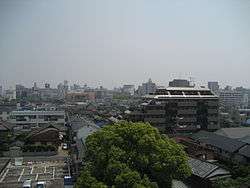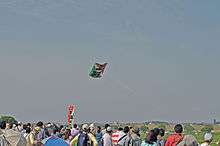Kasukabe, Saitama
Kasukabe (春日部市, Kasukabe-shi) is a city located in Saitama Prefecture, Japan. As of 1 February 2016, the city had an estimated population of 232,294, and a population density of 3520 persons per km². Its total area is 66.00 km². Kasukabe is famous for the production of kiri-tansu (桐箪笥), traditional dressers made from paulownia wood. The cultural and economic value of the paulownia is reflected in its designation as the official town tree.
Kasukabe 春日部市 | |
|---|---|
 View of central Kasukabe | |
 Flag  Seal | |
 Location of Kasukabe in Saitama Prefecture | |
 Kasukabe Location of Kasukabe in Saitama Prefecture | |
| Coordinates: 35°58′30.9″N 139°45′8.2″E | |
| Country | Japan |
| Region | Kantō |
| Prefecture | Saitama Prefecture |
| Area | |
| • Total | 66.00 km2 (25.48 sq mi) |
| Population (February 2016) | |
| • Total | 232,294 |
| • Density | 3,520/km2 (9,100/sq mi) |
| Time zone | UTC+9 (Japan Standard Time) |
| - Tree | Paulownia tomentosa |
| - Flower | Wisteria |
| - Bird | Black-headed gull |
| Phone number | 048-736-1111 |
| Address | 6-2 Chuo, Kasukabe-shi, Saitama-ken 344-8577 |
| Website | www.city.kasukabe.lg.jp |

Geography
Kasukabe is located in far eastern Saitama Prefecture.
Surrounding municipalities
- Saitama Prefecture
- Koshigaya
- Saitama
- Shiraoka
- Miyashiro
- Sugito
- Matsubushi
- Chiba Prefecture
History
During the Edo period, Kasukabe prospered as a post station on the Nikkō Kaidō highway linking Edo with Nikkō. The modern town of Kasukabe was created within Minamisaitama District, Saitama with the establishment of the municipalities system on April 1, 1889. On April 1, 1944, Kasukabe annexed the neighboring village of Uchimaki. On July 1, 1954, Kasukabe was elevated to city status after annexing the villages of Toyoharu, Takesato, Komatsu and Toyono. On October 1, 2005, old Kasukabe city and the town of Shōwa (from Kitakatsushika District) were merged into the new and expanded city of Kasukabe. Kasukabe was elevated to special city status on April 1, 2008, giving it increased local autonomy.
Economy
Kasukabe is a regional commercial center with a mixed economy.
Education
- Kyoei University
- Kasukabe has 24 elementary schools and one private and 13 public middle schools. The city also has five public high schools, including the Saitama Prefectural Kasukabe High School and Kasukabe Girls' Senior High School. There is one special education school in the city,
Transportation
Railway
System City relations

.svg.png)
Local attractions
- Metropolitan Area Outer Underground Discharge Channel has a public entrance in Kasukabe. Also known as G-CANs, this huge underground flood control system was completed in 2009. The monumental main storage chamber, sometimes called the "underground temple", has been the setting for TV shows and commercials. It is open to tours.
- Kasukabe Hachiman-gu
- Ushijima Wisteria
- Uchiaki Park
Shopping
Kasukabe is home to what was formerly one of the two Robinsons department stores in Japan, which became a Seibu department store in March 2013. The large, seven-story American-style store is a landmark for residents. It is located on the east side of Kasukabe Station. However, Seibu is scheduled to close its doors due to a shortage of business, likely caused by competition with Aeon Mall.[4]
Close to the west entrance to the station is a shopping mall, known as Lala Garden, housing several chain retail stores, such as Uniqlo, Gap, ABC-Mart, as well as a supermarket, 100 yen shop, and more. There is also an Ito-Yokado on the west side of the station.

In March 2013, an Aeon mall opened on National Route 16, which shoppers can either reach by car, or by taking a regularly scheduled bus from the east entrance of the station. This mall, as well as Lala Garden, has a movie theatre.
In popular culture
Kasukabe is the setting of the manga and anime series Lucky Star and Crayon Shin-chan. Shin-chan's creator Yoshito Usui also lived in Kasukabe.[5]
References
- "Japan Visitation". pasadenajaycees.org. Retrieved 14 March 2015.
- 公益社団法人春日部青年会議所. kasukabe-jc.com. Retrieved 14 March 2015.
- "International Exchange". List of Affiliation Partners within Prefectures. Council of Local Authorities for International Relations (CLAIR). Archived from the original on 4 January 2016. Retrieved 21 November 2015.
- "Archived copy". Archived from the original on 2015-11-19. Retrieved 2015-10-09.CS1 maint: archived copy as title (link)
- "Crayon Shin-chan Manga Creator Usui Missing Since Friday". Anime News Network. September 15, 2009. Retrieved September 16, 2009.
External links
| Wikimedia Commons has media related to Kasukabe, Saitama. |
- Official Website (in Japanese)